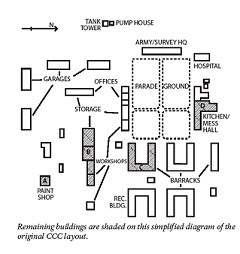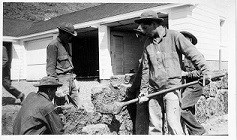
The Camp
Civilian Conservation Corps
The Civilian Conservation Corps (CCC) was established in 1933 by President Franklin Roosevelt to provide six months to two years employment and vocational training for young men ages 17-28. CCC enrollees were paid $30 a month, $25 of which was sent home or put into a savings account. The CCC program lasted more than nine years and enrolled a grand total of more than 2.5 million men. Enrollees at Camp Tulelake constructed a duck hospital, an administrative headquarters, the supervisor’s residences, and a lookout cabin on the bluff behind the Refuge Visitor Center. Mexican American stone masons constructed over 300 feet of rock wall around the Refuge Headquarters. Camp Tulelake and the Klamath Reclamation ProjectTogether Camp Tulelake and Camp Klamath played a large role in the expansion of available land for the Klamath Reclamation Project. They built water control structures of timber and concrete, dug ditches, repaired ten breaks in the canal banks, and increased the Clear Lake reservoir's capacity by about 60,000 acre-feet. As enrollees left the camp to join the war effort the camp was closed during the summer of 1942. Japanese Americans
In March 1943, over 100 men from the Tule Lake War Relocation Center were housed at Camp Tulelake after refusing to answer the War Relocation Authority’s loyalty questionnaire. After several months, they were either released to the Tule Lake Segregation Center or sent elsewhere. While being housed at the camp, internees completed $2,500 in repairs to the buildings, including installing new stove pipes, repairing the sewer systems, and repairing or replacing doors and electrical fixtures. After the Tule Lake War Relocation Center was converted into the Segregation Center, and after a fatal farm accident, internees went on strike, refusing to harvest crops that would be sent to other camps. To break the strike, 243 internees were transferred from other war relocation center to bring in the harvest. Since they were paid higher wages than the Tule Lake internees, they were housed at Camp Tulelake for their protection. Italian & German POWs
With so many local men and women participating in World War II, the town of Tulelake did not have enough hands to bring in the harvest, so the Tulelake Growers Association petitioned the US Government for help. The federal government replied by sending 150 Italian Prisoners of War in May 1944. The Italian POWs converted the area to accommodate the German prisoners that would start arriving from Camp White (near Medford, Oregon) in June. The Italian POWs lived in tents in the town of Tulelake while they set up fences, barbed wire, latrines, water lines, guard towers, and search lights around the camp. At its peak in October 1944, the camp housed 800 German POWs who helped plant, tend, and harvest onion and potato crops. Without their help and hard work, local crops would not have been harvested before the harsh winter set in. POW’s lived and worked in the area until the camp was closed in 1946. Some even applied for the lottery of local homesteads, but none were drawn. After the Camp Was ClosedIn 1946 the Army transferred the camp back to the Fish and Wildlife Service. At this time three of the barracks were moved to the Sacramento Wildlife Refuge for staff quarters. One section of a building was converted into a muskrat skinning shed. This shed was converted into a covered lumber drying shed in 1963. During the 1950’s many of the buildings were used for storage, and the mess hall was converted into temporary housing. Pacific Region Sign ShopLocated inside the north end of the remaining barrack, the Regional Sign Shop produced signs for all wildlife refuges in California, Oregon, Washington, Idaho, Nevada and Hawaii. Sign production started in May 1960 and continued until it closed in December 1974. During its operation the sign shop produced over 6,000 wood, metal, and colored signs. Restoration ProjectsStarting in 2006, the Klamath Basin Wildlife Refuge Association (KBWRA) received a “Preserve America” grant to begin stabilizing one portion of the barrack. With the help of local volunteers donating over 800 hours the KBWRA was able to re-level approximately 4,000 square feet of the floor, and replaced the deteriorated wood shingle roof with a temporary protective sheet metal roof. In an effort to restore the building to its original look, four windows were reinstalled to their original locations, a stone fire chimney was removed, and non-original interior walls were removed. Current and Future ProjectsDuring the spring and summer of 2009, the Klamath Basin Wildlife Refuge Association will be working on replacing the flooring in the north wing of the barracks. 

|
Last updated: January 23, 2023
